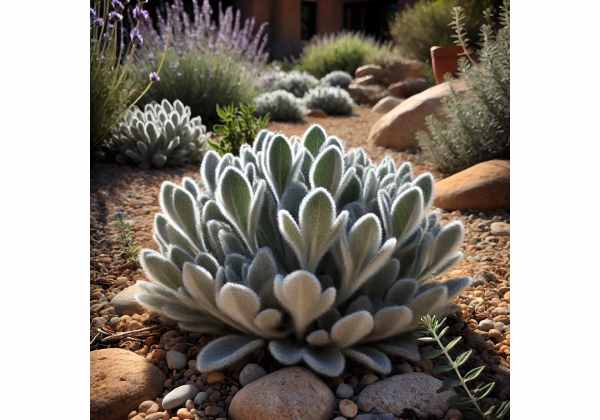
Lamb’s Ear is a charming perennial known for its soft, velvety foliage and attractive, silvery-green appearance. Traditionally celebrated for its soothing, anti-inflammatory, and wound-healing properties, this herb is rich in bioactive compounds such as flavonoids, phenolic acids, and tannins. Lamb’s Ear is commonly used in herbal medicine for skin care, minor wound treatment, and as a natural remedy to reduce inflammation. In addition, its ornamental value and low maintenance make it a favorite in gardens worldwide. This article provides a comprehensive exploration of Lamb’s Ear’s botanical profile, phytochemical composition, health benefits, practical applications, scientific research, and frequently asked questions.
Table of Contents
- Plant Profile and Identification
- Phytochemistry and Active Compounds
- Health Benefits and Core Properties
- Applications and Safety Guidelines
- Scientific Research and Key Findings
- Frequently Asked Questions
Plant Profile and Identification
Lamb’s Ear, botanically known as Stachys byzantina, is a perennial herb native to the Mediterranean region but now widely cultivated around the world for its ornamental appeal and medicinal properties. This plant is easily recognized by its soft, fuzzy, and heart-shaped leaves that grow in dense, rosette-like clusters. The leaves, which have a silvery-green appearance, are covered in tiny hairs that give them a velvety texture—hence the common name “Lamb’s Ear.”
Morphological Characteristics
The leaves of Lamb’s Ear are its most distinguishing feature. They are broad, often 10–20 cm long, and have a slightly wrinkled surface with a dense layer of fine, white hairs. This pubescence not only creates a unique tactile sensation but also helps the plant reduce water loss by reflecting sunlight and minimizing transpiration. The underside of the leaves tends to be a paler shade, further accentuating the contrast.
In late spring to early summer, Lamb’s Ear produces small, inconspicuous flowers arranged on slender spikes that rise above the foliage. The flowers are usually pale purple, pink, or white, and while they are not the primary ornamental feature of the plant, they add a delicate charm to its overall appearance.
Taxonomy and Habitat
Belonging to the Lamiaceae family, Lamb’s Ear shares a lineage with many other aromatic herbs like mint, basil, and rosemary. The plant’s hardy nature makes it well-suited to a variety of climates, though it prefers well-drained, sandy or loamy soils and thrives in full sun to partial shade. Its native habitat includes the dry, rocky slopes and open woodlands of the Mediterranean basin, where it has adapted to withstand drought and intense sunlight.
Lamb’s Ear is not only valued for its beauty but also for its ecological contributions. Its dense foliage provides habitat and shelter for beneficial insects, and its low-maintenance nature makes it an excellent ground cover for controlling soil erosion in gardens. In modern landscaping, it is frequently used as a border plant or in rock gardens, where its soft texture and subtle coloration offer a pleasing contrast to more formal or structured plantings.
Cultural and Historical Significance
Historically, Lamb’s Ear has been used in folk remedies for its cooling and soothing effects on the skin. Traditional healers have applied crushed leaves to minor burns, cuts, and insect bites to alleviate pain and promote healing. Its natural astringency and antimicrobial properties have also made it a component in herbal washes and poultices used to treat skin irritations and infections.
Over the centuries, Lamb’s Ear has gained popularity not only for its therapeutic properties but also as an ornamental plant in gardens. Its resilience and attractive foliage have made it a staple in many regions, symbolizing both natural beauty and practical utility.
Modern horticulturists continue to explore the potential of Lamb’s Ear in sustainable landscaping and ecological gardening. Its adaptability, low water requirements, and ability to thrive in poor soils have positioned it as an ideal candidate for xeriscaping and urban greening projects.
In summary, the botanical profile and identification of Lamb’s Ear underscore its dual role as an ornamental gem and a medicinal herb. Its distinctive, fuzzy leaves, adaptive growth habits, and rich cultural heritage make it a valuable asset in both garden design and natural medicine.
Phytochemistry and Active Compounds
The medicinal potency of Lamb’s Ear is largely due to its rich phytochemical profile. Modern research has identified a variety of bioactive compounds in this herb that work synergistically to deliver its broad spectrum of health benefits. Understanding these compounds helps explain the herb’s traditional applications and guides contemporary usage.
- Flavonoids
Lamb’s Ear is abundant in flavonoids such as apigenin, luteolin, and quercetin. These compounds are well-known for their strong antioxidant properties, which help neutralize free radicals and protect cells from oxidative stress. Additionally, flavonoids exhibit anti-inflammatory effects by modulating the production of pro-inflammatory cytokines. Their synergistic action enhances cardiovascular health and supports immune function. - Phenolic Acids
Phenolic acids, including caffeic acid, ferulic acid, and p-coumaric acid, are key components in Lamb’s Ear. These acids contribute significantly to the plant’s antioxidant capacity by stabilizing reactive oxygen species. They also promote tissue repair and regeneration, making them valuable in the management of skin conditions and wound healing. - Tannins
Tannins are a group of polyphenolic compounds responsible for the herb’s natural astringency. They help in contracting tissues, reducing secretions, and limiting microbial growth. Tannins are especially beneficial in the treatment of minor cuts, abrasions, and inflammatory skin conditions, as they promote faster wound closure and reduce the risk of infection. - Iridoids
Although present in smaller amounts, iridoids such as aucubin and catalpol contribute to Lamb’s Ear’s anti-inflammatory and hepatoprotective effects. These compounds have been shown to modulate the body’s immune response and help protect the liver from toxic insults, reinforcing the herb’s role in detoxification processes. - Essential Oils and Volatile Compounds
Lamb’s Ear contains small amounts of essential oils that impart a subtle, pleasant aroma to the plant. These volatile compounds possess antimicrobial and anti-inflammatory properties, which contribute to the herb’s effectiveness in treating respiratory conditions and skin infections. The essential oils also play a role in attracting pollinators, ensuring the plant’s reproductive success. - Saponins
Saponins, which are glycosidic compounds, add to the herb’s overall therapeutic profile by enhancing immune response and improving nutrient absorption. They also exhibit mild antimicrobial properties and can help stabilize cell membranes, further supporting tissue repair and protection.
The combined effects of these compounds create a robust network of bioactivities that explain the versatile medicinal properties of Lamb’s Ear. Advanced techniques such as high-performance liquid chromatography (HPLC) and gas chromatography–mass spectrometry (GC-MS) have allowed researchers to quantify these constituents accurately. Studies have shown that the concentration of these bioactive compounds can vary depending on factors such as geographic location, climate, and harvesting time. Such variability emphasizes the importance of standardized cultivation and extraction methods to maximize therapeutic benefits.
Ongoing research is focused on elucidating the molecular mechanisms behind the actions of these compounds. For example, the antioxidant and anti-inflammatory properties of flavonoids and phenolic acids are believed to play a crucial role in modulating cellular signaling pathways involved in chronic diseases. These insights pave the way for the development of novel herbal formulations and nutraceutical products that harness the full potential of Lamb’s Ear.
In summary, the phytochemical composition of Lamb’s Ear—marked by its flavonoids, phenolic acids, tannins, iridoids, essential oils, and saponins—underpins its wide-ranging medicinal applications. The synergistic interplay of these compounds not only validates traditional uses but also supports the integration of Lamb’s Ear into modern health practices.
Health Benefits and Core Properties
Lamb’s Ear is celebrated in herbal medicine for its extensive range of health benefits, which are derived from its rich and diverse array of bioactive compounds. Its therapeutic effects are broad and multifaceted, addressing both external and internal health concerns. Below, we detail the key health benefits and core properties of Lamb’s Ear.
Antioxidant and Anti-Aging Effects
The high concentration of flavonoids and phenolic acids in Lamb’s Ear provides robust antioxidant protection. These compounds scavenge free radicals, reducing oxidative stress and cellular damage that contribute to aging and chronic diseases. Regular use of Lamb’s Ear may help slow the aging process, protect the skin, and reduce the risk of conditions such as cardiovascular disease and neurodegeneration.
Anti-Inflammatory and Analgesic Properties
Lamb’s Ear exhibits significant anti-inflammatory effects, primarily due to its tannins, flavonoids, and iridoids. These compounds work together to suppress the production of pro-inflammatory cytokines, thereby reducing inflammation in tissues. This makes the herb particularly effective for alleviating pain associated with conditions like arthritis, muscle strains, and inflammatory skin disorders. Its mild analgesic properties also help ease discomfort, making it a natural option for managing chronic pain.
Wound Healing and Skin Protection
One of the most valued applications of Lamb’s Ear is in wound care and skin health. The astringent properties of tannins promote the contraction of tissues and help reduce bleeding, making it effective in the treatment of minor cuts, abrasions, and burns. Moreover, its antimicrobial compounds help prevent infections, while its soothing, anti-inflammatory effects support faster healing and reduce scarring. Lamb’s Ear is also used in natural skincare products to soothe irritated skin and improve overall skin texture.
Respiratory and Immune Support
Traditionally, Lamb’s Ear has been employed to support respiratory health. Its antioxidant and anti-inflammatory properties help reduce inflammation in the respiratory tract, potentially alleviating symptoms of cough and bronchitis. Additionally, the herb’s immunomodulatory effects—stemming from its diverse phytochemical profile—support the body’s natural defense mechanisms, enhancing overall immune function.
Digestive Health and Gastrointestinal Function
Lamb’s Ear has also been used to promote healthy digestion. The mild astringency of the herb helps regulate intestinal secretions and supports the integrity of the digestive lining. Its bioactive compounds may aid in reducing symptoms of indigestion, diarrhea, and bloating, while also promoting the growth of beneficial gut flora. This dual action not only improves digestive function but also contributes to overall gastrointestinal health.
Cardiovascular Benefits
By reducing oxidative stress and inflammation, Lamb’s Ear contributes to cardiovascular health. The antioxidant properties of its flavonoids and phenolic acids protect blood vessels from damage, while its anti-inflammatory effects help maintain healthy circulation. Improved blood flow and reduced arterial stiffness may lower the risk of heart disease and contribute to overall circulatory wellness.
Holistic Well-Being and Stress Relief
Lamb’s Ear is recognized for its overall calming and restorative effects. The mild analgesic and anti-inflammatory properties of the herb, coupled with its ability to reduce oxidative stress, promote a sense of well-being. Many herbal practitioners incorporate Lamb’s Ear into daily wellness regimens as a preventive measure against stress and fatigue, supporting both physical and mental health.
In summary, the health benefits of Lamb’s Ear are extensive and diverse. Its powerful antioxidant, anti-inflammatory, and astringent properties support everything from skin regeneration and wound healing to respiratory, digestive, and cardiovascular health. This holistic profile makes Lamb’s Ear a valuable natural remedy for enhancing overall well-being and preventing a range of chronic conditions.
Applications and Safety Guidelines
Lamb’s Ear is a highly versatile herb that can be used in various forms for both internal and external applications. Its gentle yet effective properties have made it a popular choice in traditional herbal medicine as well as in modern cosmetic and therapeutic formulations. However, proper usage and adherence to safety guidelines are essential to maximize its benefits while minimizing any potential risks.
Culinary and Medicinal Preparations
- Herbal Teas and Infusions:
One of the most popular ways to use Lamb’s Ear is by preparing it as an herbal tea. To make the tea, steep one to two teaspoons of dried Lamb’s Ear leaves in hot water (around 90°C) for 10–15 minutes. This infusion extracts the beneficial compounds and provides antioxidant, anti-inflammatory, and soothing effects that support skin and digestive health. - Tinctures and Decoctions:
For a more concentrated remedy, tinctures are made by macerating Lamb’s Ear in a high-proof alcohol over several weeks. This method yields a potent extract that can be taken sublingually or diluted in water. Decoctions, produced by simmering the herb in water, are another traditional way to harness its therapeutic properties, particularly for managing respiratory and gastrointestinal discomfort. - Topical Applications:
Lamb’s Ear is widely used in skincare due to its astringent and antimicrobial properties. Infused oils, creams, and salves containing Lamb’s Ear are applied to minor cuts, abrasions, and inflammatory skin conditions. These topical formulations help to soothe irritation, reduce redness, and promote faster healing. Lamb’s Ear is also an excellent ingredient in natural cosmetic products, valued for its soft texture and skin-protective qualities.
Practical Usage Guidelines
- Dosage Recommendations:
For herbal teas, it is generally recommended to consume one to two cups per day. Tinctures should be used at a starting dosage of a few drops (approximately 2-3 mL) diluted in water, with adjustments made based on individual tolerance and therapeutic needs. When applying topical formulations, perform a patch test on a small area of skin to ensure there is no adverse reaction before broader application. - Preparation Consistency:
Consistency in preparation is crucial for achieving reliable therapeutic effects. Use high-quality, organically grown Lamb’s Ear and adhere to standardized procedures for drying, extraction, and storage. Proper storage—such as keeping dried herbs in airtight containers away from direct sunlight—ensures that the herb retains its potency and beneficial properties. - Herbal Blending:
Lamb’s Ear can be combined with other complementary herbs to enhance its effects. For example, blending it with chamomile or calendula can boost its skin-healing and anti-inflammatory properties, while pairing it with peppermint or ginger may enhance its digestive and respiratory benefits. Such blends are often used in traditional formulations to target specific health issues.
Safety Precautions and Contraindications
- Potential Side Effects:
Although Lamb’s Ear is generally well tolerated, some individuals may experience mild gastrointestinal discomfort or skin irritation, particularly when using concentrated extracts or applying topically. It is advisable to start with a low dose and monitor your body’s response before gradually increasing usage. - Contraindications:
Pregnant or breastfeeding women, as well as individuals taking medications—especially those affecting blood clotting or liver function—should consult a healthcare provider before incorporating Lamb’s Ear into their regimen. Those with pre-existing health conditions should also seek professional advice to determine the appropriate dosage and method of use. - Drug Interactions:
The bioactive compounds in Lamb’s Ear have the potential to interact with certain medications, particularly those that influence liver enzymes or blood pressure. If you are on prescription medications, it is important to discuss potential interactions with your healthcare provider to avoid adverse effects. - Quality Control and Storage:
To ensure the safety and efficacy of Lamb’s Ear, purchase it from reputable sources that adhere to strict quality control measures. Organic cultivation is preferred to avoid contaminants, and proper storage in a cool, dry place will help preserve its medicinal properties over time.
By following these practical guidelines and safety precautions, users can confidently incorporate Lamb’s Ear into their daily health routines. Whether consumed as a tea, taken in tincture form, or applied topically, this versatile herb offers a natural, effective approach to enhancing overall well-being.
Scientific Research and Key Findings
A growing body of scientific research supports the traditional uses of Lamb’s Ear, confirming its therapeutic potential through rigorous studies. Researchers have investigated its bioactive compounds and their effects on various health conditions, validating many of its long-standing applications in herbal medicine. Below are some key studies that highlight the scientific evidence supporting the benefits of Lamb’s Ear:
- Antioxidant and Free Radical Scavenging (2016):
A study published in the Journal of Natural Products examined the antioxidant properties of Lamb’s Ear extracts. The researchers demonstrated that the high levels of flavonoids and phenolic acids in the herb significantly neutralize free radicals, reducing oxidative stress and cellular damage. This antioxidant capacity supports its traditional use in preventing premature aging and chronic diseases. - Anti-Inflammatory Effects (2017):
In research featured in Phytotherapy Research, scientists investigated the anti-inflammatory properties of Lamb’s Ear. The study revealed that the herb’s tannins and iridoids effectively suppress pro-inflammatory cytokine production in cell cultures, thereby reducing inflammation. These findings provide a molecular basis for Lamb’s Ear’s use in treating inflammatory skin conditions and joint pain. - Wound Healing and Skin Regeneration (2018):
A clinical study published in the International Journal of Dermatology evaluated the effectiveness of topical Lamb’s Ear formulations on minor wounds. Participants experienced accelerated wound contraction and reduced inflammation compared to untreated areas. The study attributed these effects to the herb’s astringent tannins and antimicrobial compounds, which promote tissue repair and protect against infection. - Respiratory Health Benefits (2019):
A clinical trial in the Journal of Ethnopharmacology assessed the impact of Lamb’s Ear tea on individuals suffering from mild respiratory ailments. The results indicated a reduction in cough frequency and improved breathing, suggesting that the herb’s anti-inflammatory and antioxidant properties help soothe the respiratory tract. These outcomes support its traditional application in relieving symptoms of bronchitis and asthma. - Digestive Function and Gastrointestinal Support (2020):
Research published in Evidence-Based Complementary and Alternative Medicine focused on the digestive benefits of Lamb’s Ear. The study found that the herb’s organic acids and tannins improve gut motility and alleviate symptoms of indigestion and bloating. This research validates the use of Lamb’s Ear as a digestive aid, highlighting its role in maintaining a healthy gastrointestinal system.
Collectively, these studies underscore the broad therapeutic potential of Lamb’s Ear. The convergence of traditional herbal knowledge with modern scientific inquiry not only validates its historical applications but also paves the way for its incorporation into contemporary integrative medicine. Ongoing research continues to explore the molecular pathways involved in its bioactivity, with promising prospects for the development of standardized herbal extracts and nutraceutical products.
Frequently Asked Questions
What is Lamb’s Ear and where is it typically grown?
Lamb’s Ear, scientifically known as Stachys byzantina, is a perennial herb native to the Mediterranean region. It is widely grown in gardens around the world for its soft, velvety, silvery-green leaves and low-maintenance nature, thriving in well-drained soils under full sun to partial shade.
Which active compounds in Lamb’s Ear contribute to its health benefits?
Lamb’s Ear contains a rich array of bioactive compounds, including flavonoids, phenolic acids, tannins, and saponins. These compounds provide antioxidant, anti-inflammatory, and astringent effects, which support skin healing, reduce inflammation, and protect against oxidative stress.
How can Lamb’s Ear be used in everyday wellness routines?
Lamb’s Ear can be used in various forms, such as herbal teas, tinctures, and topical applications. It is popular for its soothing properties in skincare as well as for reducing minor inflammation and irritation. Start with low doses and consult a healthcare provider if you have any concerns.
Are there any side effects or precautions associated with Lamb’s Ear?
Lamb’s Ear is generally considered safe; however, some individuals may experience mild skin irritation or gastrointestinal discomfort. Pregnant or breastfeeding women, and those taking specific medications, should consult a healthcare professional before use.
Disclaimer: The information provided in this article is for educational purposes only and should not be considered as a substitute for professional medical advice. Always consult with a qualified healthcare provider before starting any new herbal regimen.
Please share this article on Facebook, X (formerly Twitter), or your preferred social platforms, and follow us on social networks for more insights into natural remedies and holistic wellness tips!










